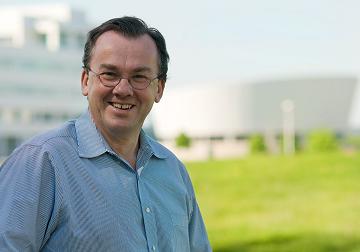Home > Press > Argonne’s J. Murray Gibson to lead AAAS Physics Section
 |
| J. Murray Gibson |
Abstract:
The U.S. Department of Energy's (DOE) Argonne National Laboratory ‘s Associate Laboratory Director J. Murray Gibson has been elected chair of the Physics Section of the American Association for the Advancement of Science (AAAS).
Argonne’s J. Murray Gibson to lead AAAS Physics Section
Argonne, IL | Posted on March 26th, 2010Gibson is responsible for the laboratory's Photon Sciences programs and serves as director of the Advanced Photon Source, the brightest source of X-rays in the western hemisphere. The APS is used to study the structures of materials and processes at the atomic scale. It is also serves the largest number of scientific users of any facility in North America, with 3,500 users visiting each year.
"AAAS is the pre-eminent society worldwide for advancing the public's perception of science," Gibson said. "I hope to explore innovative routes to raise awareness of the need for scientific research to address sustainable energy, water and health, and to excite young people to enter these fields." The section chair also plays a role in ensuring that outstanding candidates are elected as fellows of AAAS.
He will serve one year as chair-elect, and begin his chairmanship after the AAAS meeting in 2011. After one year as chairman, he will serve an additional year on the executive committee. The non-profit AAAS is open to all and fulfills its mission to "advance science and serve society" through initiatives in science policy, international programs, science education and more. AAAS seeks to "advance science, engineering, and innovation throughout the world for the benefit of all people."
AAAS has nearly 120,000 individual and institutional members and 262 affiliates, serving 10 million scientists in fields ranging from plant biology to dentistry.
The association's 24 sections correspond to fields of interest among AAAS members, from specific fields like physics, biology and chemistry to general interest in science. The sections arrange symposia for the Annual Meeting, elect officers and provide expertise for association-wide projects.
Gibson joined Argonne in 1998 as director of the Materials Science Division. He led Argonne's initial efforts in nanoscience, which eventually led to the establishment of the Center for Nanoscale Materials. He was appointed to his current position in 2001. Gibson's research, focused on the use of innovative electron diffraction techniques in the study of materials physics in thin films and supported by the DOE Office of Science, has resulted in more than 180 journal papers and 120 invited presentations at conferences.
####
About Argonne National Laboratory
The U.S. Department of Energy's Argonne National Laboratory seeks solutions to pressing national problems in science and technology. The nation’s first national laboratory, Argonne conducts leading-edge basic and applied scientific research in virtually every scientific discipline. Argonne researchers work closely with researchers from hundreds of companies, universities, and federal, state and municipal agencies to help them solve their specific problems, advance America’s scientific leadership and prepare the nation for a better future. With employees from more than 60 nations, Argonne is managed by UChicago Argonne, LLC for the U.S. Department of Energy’s Office of Science.
For more information, please click here
Contacts:
Brock Cooper
(630) 252-5565
Copyright © Argonne National Laboratory
If you have a comment, please Contact us.Issuers of news releases, not 7th Wave, Inc. or Nanotechnology Now, are solely responsible for the accuracy of the content.
| Related News Press |
News and information
![]() Researchers develop molecular qubits that communicate at telecom frequencies October 3rd, 2025
Researchers develop molecular qubits that communicate at telecom frequencies October 3rd, 2025
![]() Next-generation quantum communication October 3rd, 2025
Next-generation quantum communication October 3rd, 2025
![]() "Nanoreactor" cage uses visible light for catalytic and ultra-selective cross-cycloadditions October 3rd, 2025
"Nanoreactor" cage uses visible light for catalytic and ultra-selective cross-cycloadditions October 3rd, 2025
Materials/Metamaterials/Magnetoresistance
![]() First real-time observation of two-dimensional melting process: Researchers at Mainz University unveil new insights into magnetic vortex structures August 8th, 2025
First real-time observation of two-dimensional melting process: Researchers at Mainz University unveil new insights into magnetic vortex structures August 8th, 2025
![]() Researchers unveil a groundbreaking clay-based solution to capture carbon dioxide and combat climate change June 6th, 2025
Researchers unveil a groundbreaking clay-based solution to capture carbon dioxide and combat climate change June 6th, 2025
![]() A 1960s idea inspires NBI researchers to study hitherto inaccessible quantum states June 6th, 2025
A 1960s idea inspires NBI researchers to study hitherto inaccessible quantum states June 6th, 2025
![]() Institute for Nanoscience hosts annual proposal planning meeting May 16th, 2025
Institute for Nanoscience hosts annual proposal planning meeting May 16th, 2025
Announcements
![]() Rice membrane extracts lithium from brines with greater speed, less waste October 3rd, 2025
Rice membrane extracts lithium from brines with greater speed, less waste October 3rd, 2025
![]() Researchers develop molecular qubits that communicate at telecom frequencies October 3rd, 2025
Researchers develop molecular qubits that communicate at telecom frequencies October 3rd, 2025
![]() Next-generation quantum communication October 3rd, 2025
Next-generation quantum communication October 3rd, 2025
![]() "Nanoreactor" cage uses visible light for catalytic and ultra-selective cross-cycloadditions October 3rd, 2025
"Nanoreactor" cage uses visible light for catalytic and ultra-selective cross-cycloadditions October 3rd, 2025
Photonics/Optics/Lasers
![]() ICFO researchers overcome long-standing bottleneck in single photon detection with twisted 2D materials August 8th, 2025
ICFO researchers overcome long-standing bottleneck in single photon detection with twisted 2D materials August 8th, 2025
![]() Institute for Nanoscience hosts annual proposal planning meeting May 16th, 2025
Institute for Nanoscience hosts annual proposal planning meeting May 16th, 2025
|
|
||
|
|
||
| The latest news from around the world, FREE | ||
|
|
||
|
|
||
| Premium Products | ||
|
|
||
|
Only the news you want to read!
Learn More |
||
|
|
||
|
Full-service, expert consulting
Learn More |
||
|
|
||








